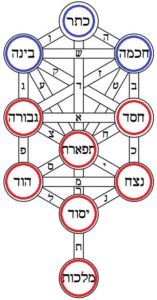
The Sefirot of mochin above (in blue) and the Sefirot of the middot below (in red) on the mystical “Tree of Life”.
This week, in parashat Yitro, we read the Ten Commandments. As with all other things that are ten in the Torah, the Ten Commandments correspond neatly to the Ten Sefirot. Just as the first three of the Sefirot are on a higher plane, referred as the mochin, the first three of the Commandments are also distinct and relate directly to God (to know there is a God, to have no other gods or idols, and not to take God’s Name in vain). We saw a similar division of ten into groups of three and seven in the Ten Plagues, where the first seven are read in parashat Va’era, and the final three in parashat Bo. Likewise, we find a division of ten into three and seven in the very first case of ten: the Ten Utterances of Creation.
As our Sages famously teach, God created the entire universe through Ten Utterances (Avot 5:1). When we look in the first chapter of Genesis at the account of Creation, we find the expression “And God said” exactly 10 times. It was through these Ten Utterances that God brought the entire cosmos into existence. It is important to note that the last instance of “And God said” (1:29) is really just a continuation of the ninth instance (1:28). The actual remaining Utterance is the first word of the Torah: Beresheet. This word itself was the First Utterance, and was the initial burst of energy that brought a dark universe into existence. The Second Utterance was “Let there be light”, and the Third was “Let there be a firmament”. While the first three clearly involve grand cosmic developments, the remaining seven Utterances all relate specifically to Earth.
Of course, all of the above tens correspond to the Ten Sefirot, the first emanations that emerged out of God’s Infinite Ein Sof. The Ten Sefirot permeate all of existence, which is why we find so many patterns of ten in the Torah and all around us in Creation. The notion of Ten Sefirot is a foundational and inseparable part of Judaism, yet few are aware of where all the information about the Sefirot came from! It is commonly thought that the Sefirot were first revealed by the Zohar, but this is highly inaccurate. Discussion of the Sefirot dates back centuries before the first publication of the Zohar. So, let’s take a brief trip back in time to explore the historical revelation of the Sefirot. Continue reading →


